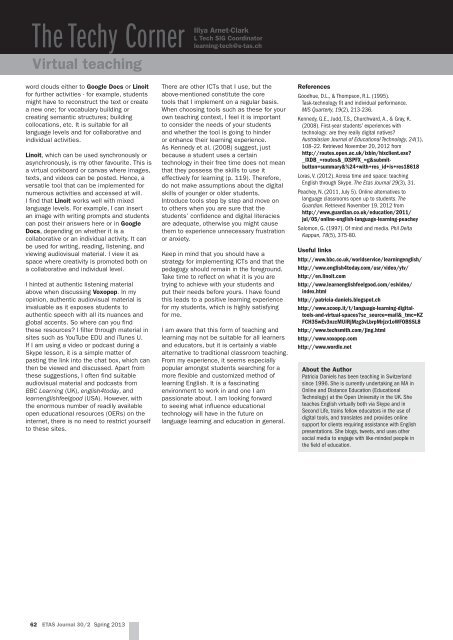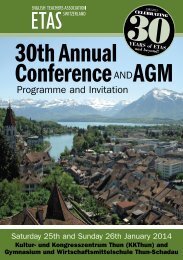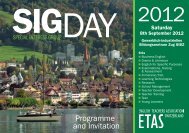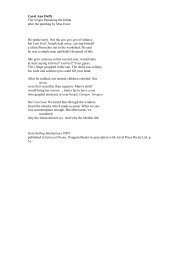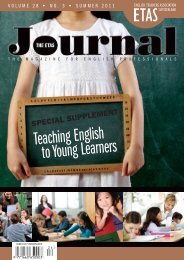The Techy CornerVirtual teachingIllya Arnet-ClarkL Tech SIG Coordinatorlearning-tech@e-tas.chPAT R I C I A D A N I E L SWhen I commenced teaching, I neverthought that one day I would be introducingmyself as a Virtual Teacher. And I neverthought that I would be confronted with somany unusual reactions when I reveal topeople what I do, especially in <strong>Switzerland</strong>.Some smile awkwardly and change thesubject. Others take a more direct approachand prod me, making sure I am real, Isuppose, and not some kind <strong>of</strong> bio-inspiredrobot. Then there are others who haveexperience in this field and are keen toengage in discussion about informationcommunication technologies (ICTs), theirrelevance and possible uses in a virtuallearning environment (VLE).The form <strong>of</strong> virtual or cyber teaching that Iam involved in is teaching that is mediatedthrough the internet using a web-conferencingsystem such as Skype. I was prompted intowriting this text after reading the articlefrom Vicky Loras (2012) about her personalexperience with Skype in the context <strong>of</strong><strong>English</strong> language teaching (p. 31). It wasrefreshing to hear her speaking soenthusiastically and openly about herexperiment with this form <strong>of</strong> teaching andhow both she and her student developedtheir digital literacies as the lessonsprogressed. In this article I will briefly explainhow to get started as a Skype teacherand then discuss the core tools that I useto enhance the learning experience formy students.If the ELT researcher David Graddol iscorrect with his prediction that demandsfor <strong>English</strong> language learning “will peak ataround two billion learners in the next 10to 15 years” (cited in Peachey, 2011),then I believe it is time for teachers to startthinking about alternative methods <strong>of</strong>providing language instruction. If I wasto apply Goodhue and Thompson’stask-technology fit theory (1995) to thismodel <strong>of</strong> teaching, then using a Voice overInternet Protocol system (VoIP), such asSkype, seems a logical and appropriatechoice <strong>of</strong> tool. It is perfect for oralcommunication (even with the slighttechnical disturbances that can occur).It is synchronous, which means authentic,real-time interaction; you can see oneanother, which means body language canbe read to a certain extent, therebyhighlighting a sense <strong>of</strong> presence; it doesnot require high-level digital literacies,which means most students will not becognitively challenged with the medium andcan concentrate on language learning(Salomon, 1997), and it is free. I use SkypePremium (monthly or yearly subscriptionpossible) because <strong>of</strong> extra features such asgroup video calling and group screensharing, but this is not a necessity if you areworking purely on a one-to-one basis withstudents. It would seem, then, that teachinglanguage virtually is a feasible alternative totraditional forms <strong>of</strong> language learning.Getting startedYou will need to download the Skypes<strong>of</strong>tware that is compatible with yourcomputer. A webcam is essential if you donot have a built-in camera and I wouldsuggest buying a headset with combinedmicrophone so as not to be disturbed by anyexternal background noises whilst teaching.When using a headset, I find I canconcentrate intensively on the student’spronunciation. If you have never used anykind <strong>of</strong> video conferencing system before,then find someone to test it out on – forinstance, family, friends, or a fellow teacher– and play with the system. Practisenavigating around the screen, try out thechat box, test screen share mode andswapping between websites, upload andsend documents and photos, copy andpaste links into the chat box and open themup. While you are experimenting with thistool, think about how you can incorporatethese features into a lesson (keeping inmind which pedagogical approaches will bemost suitable).Ensure your students also have Skypes<strong>of</strong>tware installed and all the necessaryhardware. You will need to accept each otheras contacts before you can give them avideo call. I always do a test run withstudents before the first <strong>of</strong>ficial lesson inorder to check connectivity. Additionally,I inquire about their experience with Skypeand which ICTs they are using on a regularbasis so as to gain a brief overview <strong>of</strong>their digital competency and also to seeif any <strong>of</strong> their uses overlap with mine.Communicating is the easy part. Locate thestudent’s name in your Skype contact list,click on video call, and when they appear onyour screen, start speaking. The chat boxcan be utilized to assist with vocabularybuilding, to demonstrate how to break wordsinto syllables when pronunciation problemsoccur, to play word games and to giveprompts, and so on. Now that phase one isestablished and you can communicate, letus move onto some other tools in order tobuild up your repertoire <strong>of</strong> digital resources.Core tools and virtual spacesSome <strong>of</strong> the tools that I am about todiscuss are tools that enable me to providevirtual spaces for my students so thatliteracy skills can be practised. Theadvantage <strong>of</strong> having virtual spaces is thatmaterial can be archived for review; thusstudents can compare their progress andI have an overview <strong>of</strong> the work they areproducing. Some further plus points are thatstudents do not feel so isolated; I can caterfor various learning styles or preferences;the work areas enable flexibility; studentsare empowered with responsibility for theirown learning; creativity is promoted; thelessons are more student-centric, somethingthat is not always easy to achieve in thisspecific VLE; and, apart from improving theirlanguage skills, students’ digital literaciesbenefit. This is a welcome side effect asthese skills can be transposed into work,school, or private contexts. I work mainlywith adult students so security issues arenot a problem but, <strong>of</strong> course, if you areworking with younger students, this willneed to be addressed and I would adviseinvolving the parents.A tool that I use on a daily basis is Jing, ascreencast and screenshot s<strong>of</strong>tware, whichrequires downloading. It is an asynchronoustool. I use this to give audiovisual feedback,create tutorials, and set homework.Students respond well to this method <strong>of</strong>feedback, perhaps because it is easier toavoid ambiguity with audiovisual feedbackas opposed to written. After creating ascreencast or screenshot with Jing, I sendthe student the URL for the video, whichthey can view repeatedly from any device.Active engagement with the material ispromoted and they can archive the URL forfuture use. Jing is user-friendly and can beutilized for individual or collaborativeactivities (including mixed language levels).Voxopop is an asynchronous web-basedaudio tool that I encourage my studentsto use regularly for speaking and listeningpractice. I create private talk groups so thatmy students can communicate with oneanother, or respond to prompts. It is usefulfor discussions, feedback, dictation,storytelling, oral exam practice, vocabularygames, etc. Additionally, students canexplore public groups for extra listening andspeaking practice. The advantage is thatthey are exposed to numerous accents andauthentic language, as opposed to seteducational material. It is suitable for alllanguage levels.For writing skills, I use Google Docs/Driveas a private space where students havetheir individual wikis and group wikis forcollaborative work. During the virtual lesson,we practise writing here or I upload imagesfor speaking and writing prompts. Studentscomplete their homework in this space andI can access it at will in order to preparefeedback, which saves precious lesson timefor other activities. Google Docs can beused as a synchronous and asynchronoustool. If students choose to engagesynchronously in collaborative written work,then they can communicate via the chatbox in Google Docs and do not have touse Skype.Wordle is a web-based tool and notnecessarily designed for education.Nevertheless, it can be repurposed asan effective language tool for synchronousand asynchronous activities. It producesword clouds from extracts <strong>of</strong> text that youcopy and paste into a box. I upload theseETAS <strong>Journal</strong> 30/2 <strong>Spring</strong> <strong>2013</strong> 61
The Techy CornerIllyaVirtual teachingArnet-ClarkL Tech SIG Coordinatorlearning-tech@e-tas.chword clouds either to Google Docs or Linoitfor further activities - for example, studentsmight have to reconstruct the text or createa new one; for vocabulary building orcreating semantic structures; buildingcollocations, etc. It is suitable for alllanguage levels and for collaborative andindividual activities.Linoit, which can be used synchronously orasynchronously, is my other favourite. This isa virtual corkboard or canvas where images,texts, and videos can be posted. Hence, aversatile tool that can be implemented fornumerous activities and accessed at will.I find that Linoit works well with mixedlanguage levels. For example, I can insertan image with writing prompts and studentscan post their answers here or in GoogleDocs, depending on whether it is acollaborative or an individual activity. It canbe used for writing, reading, listening, andviewing audiovisual material. I view it asspace where creativity is promoted both ona collaborative and individual level.I hinted at authentic listening materialabove when discussing Voxopop. In myopinion, authentic audiovisual material isinvaluable as it exposes students toauthentic speech with all its nuances andglobal accents. So where can you findthese resources? I filter through material insites such as YouTube EDU and iTunes U.If I am using a video or podcast during aSkype lesson, it is a simple matter <strong>of</strong>pasting the link into the chat box, which canthen be viewed and discussed. Apart fromthese suggestions, I <strong>of</strong>ten find suitableaudiovisual material and podcasts fromBBC Learning (UK), english4today, andlearnenglishfeelgood (USA). However, withthe enormous number <strong>of</strong> readily availableopen educational resources (OERs) on theinternet, there is no need to restrict yourselfto these sites.There are other ICTs that I use, but theabove-mentioned constitute the coretools that I implement on a regular basis.When choosing tools such as these for yourown teaching context, I feel it is importantto consider the needs <strong>of</strong> your studentsand whether the tool is going to hinderor enhance their learning experience.As Kennedy et al. (2008) suggest, justbecause a student uses a certaintechnology in their free time does not meanthat they possess the skills to use iteffectively for learning (p. 119). Therefore,do not make assumptions about the digitalskills <strong>of</strong> younger or older students.Introduce tools step by step and move onto others when you are sure that thestudents’ confidence and digital literaciesare adequate, otherwise you might causethem to experience unnecessary frustrationor anxiety.Keep in mind that you should have astrategy for implementing ICTs and that thepedagogy should remain in the foreground.Take time to reflect on what it is you aretrying to achieve with your students andput their needs before yours. I have foundthis leads to a positive learning experiencefor my students, which is highly satisfyingfor me.I am aware that this form <strong>of</strong> teaching andlearning may not be suitable for all learnersand educators, but it is certainly a viablealternative to traditional classroom teaching.From my experience, it seems especiallypopular amongst students searching for amore flexible and customized method <strong>of</strong>learning <strong>English</strong>. It is a fascinatingenvironment to work in and one I ampassionate about. I am looking forwardto seeing what influence educationaltechnology will have in the future onlanguage learning and education in general.ReferencesGoodhue, D.L., & Thompson, R.L. (1995).Task-technology fit and individual performance.MIS Quarterly, 19(2), 213-236.Kennedy, G.E., Judd, T.S., Churchward, A., & Gray, K.(2008). First-year students’ experiences withtechnology: are they really digital natives?Australasian <strong>Journal</strong> <strong>of</strong> Educational Technology, 24(1),108–22. Retrieved November 20, 2012 fromhttp://routes.open.ac.uk/ixbin/hixclient.exe?_IXDB_=routes&_IXSPFX_=g&submitbutton=summary&%24+with+res_id+is+res18618Loras, V. (2012). Across time and space: teaching<strong>English</strong> through Skype. The Etas <strong>Journal</strong> 29(3), 31.Peachey, N. (2011, July 5). Online alternatives tolanguage classrooms open up to students. TheGuardian. Retrieved November 19, 2012 fromhttp://www.guardian.co.uk/education/2011/jul/05/online-english-language-learning-peacheySalomon, G. (1997). Of mind and media. Phil DeltaKappan, 78(5), 375-80.Useful linkshttp://www.bbc.co.uk/worldservice/learningenglish/http://www.english4today.com/usr/video/ytv/http://en.linoit.comhttp://www.learnenglishfeelgood.com/eslvideo/index.htmlhttp://patricia-daniels.blogspot.chhttp://www.scoop.it/t/language-learning-digitaltools-and-virtual-spaces?sc_source=mail&_tmc=KZFCH35wEv3nzcMUlRjMzg3vLbrpMrjzv1oWFOBS5L8http://www.techsmith.com/jing.htmlhttp://www.voxopop.comhttp://www.wordle.netAbout the AuthorPatricia Daniels has been teaching in <strong>Switzerland</strong>since 1996. She is currently undertaking an MA inOnline and Distance Education (EducationalTechnology) at the Open University in the UK. Sheteaches <strong>English</strong> virtually both via Skype and inSecond Life, trains fellow educators in the use <strong>of</strong>digital tools, and translates and provides onlinesupport for clients requiring assistance with <strong>English</strong>presentations. She blogs, tweets, and uses othersocial media to engage with like-minded people inthe field <strong>of</strong> education.62 ETAS <strong>Journal</strong> 30/2 <strong>Spring</strong> <strong>2013</strong>


